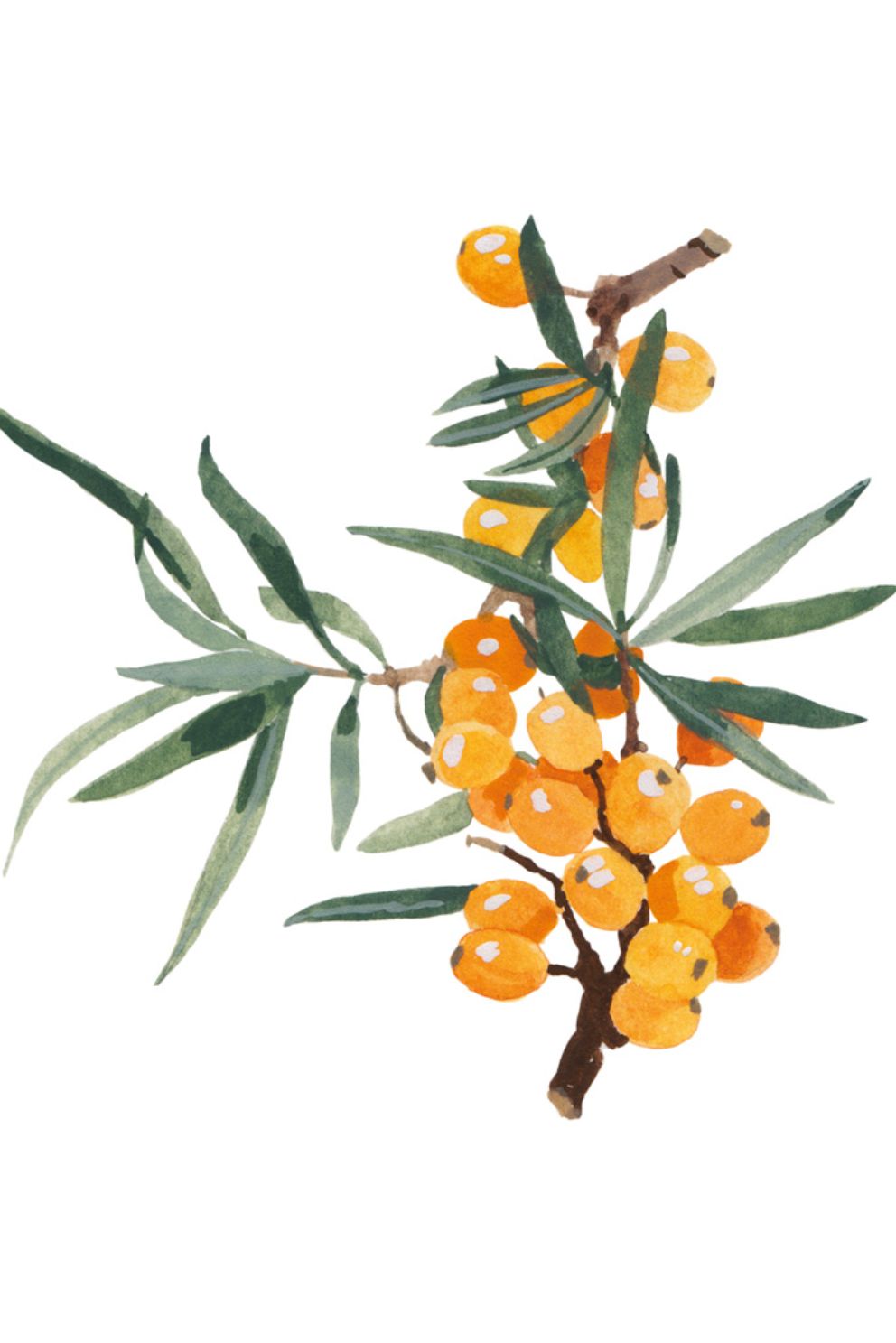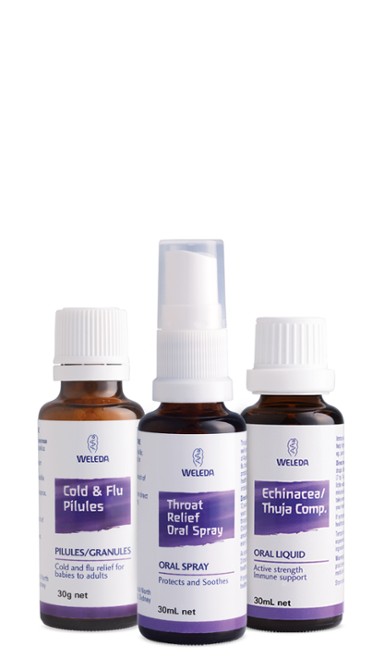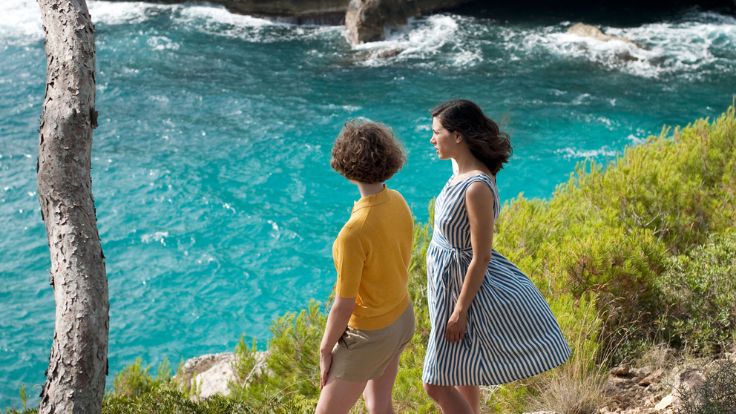
Nature’s Pharmacy
Healthy in Winter: Sea Buckthorn, St. John´s Wort, Monkshood and Black Belladonna: These medicinal plants are useful companions when days grow short. They help us to stay healthy in autumn and winter.
The dark, cold season poses challenges to both body and soul. Heightened susceptibility to infections and colds, widespread winter depression, weather and environmental conditions with their adverse effects on the skin, hampered productivity and fatigue, can push us to our limit. During this time of the year, two groups of plants in particular can provide help. Summer plants, with their strong relationship to light and heat, store summertime energies which they make available to our organism in a concentrated form in winter. Then there are poisonous plants, which are used in minute, potentised quantities in homeopathic remedies to stimulate our body’s own restorative powers.
This article presents typical representatives of these two groups: Sea buckthorn, a light-hungry survivalist; St. John’s Wort, dedicated to the summer sun; the mysterious, shade-loving Belladonna; and the highly toxic Monkshood.
Read more about how they strengthen our natural defences and bring light into the soul, when dark days dampen our spirits.
Carries within it an enormous life force
It lives in symbiosis with the bacteria in its root nodules, which fix atmospheric nitrogen, making it available to the plant. And it can’t get enough air, water and light, which are essential for its healthy growth. The unwieldy, unusual looking shrub grows up to 6 metres in height, its extensive root system anchoring the plant firmly into the ground. It protects its berries with sharp leaves and thorns. Slender, shiny, silvery green leaves covered in tiny hairs keep water from evaporating too quickly. In early August, the sea buckthorn begins producing its oblong fruits, called drupes, which grow 5 to 10 mm in size. These bright yellow and orange berries collect the radiant light and the revitalising powers of the sun, transforming them with the help of minerals and water into a treasure trove of beneficial substances. Sea buckthorn is one of the few plants that contain precious oil both in the pulp of its berries and its seeds. This enables it to produce and store not only water soluble vitamins (vitamin C and B vitamins), but also fat-soluble vitamins and their precursors (such as vitamin E and carotenoids). Thanks to its rich and balanced vitamin content, sea buckthorn is a valuable source of vitamins, also for vegetarian and vegan diets. With its antioxidants, unsaturated fatty acids and bountiful trace elements, it also protects and strengthens our cells.
Origin
Sun and sand: Sea Buckthorn (Hippophae rhamnoides) is a wild plant originating in Central Asia, and was adopted early on for its beneficial effects by traditional Tibetan medicine. During the course of thousands of years, it spread from the Himalayas over the Altai Mountains, from the Caucasus and the Carpathians up into the Alps and along the coasts of the North and Baltic Seas. Central Europe is dominated by two subspecies, while the alpine sea buckthorn boasts an even higher vitamin C content with smaller berries than its northern cousin. Optimal growing conditions for sea buckthorn also exist around the Mediterranean Sea, such as the Maremma in Tuscany. The region’s sandy soil, mild temperatures and intense sunlight in this region enable the plant to thrive especially well, producing large amounts of active substances.
Use
Good on the outside and inside: Sea buckthorn helps as a nutritional supplement during the cold season and when the immune system is weak. In the case of recurring colds, it’s best to take pure, natural Sea Buckthorn juice. If the pure juice tastes too sour, try it with cereal, mixed into (soy) yogurt or combined with other juices. When externally applied, sea buckthorn creams, lotions and oils promote healthy skin – especially in winter, when the skin can often bedry, flaky or itchy. The stored energies of the summer sun, combined with the defensive forces that it develops to survive an often hostile environment, are what make the Sea Buckthorn such a worthwhile companion, especially in winter.
The signature of the sun
As early as the 16th century, Paracelsus, the Swiss German physician, recognised strong relationship to the sun exhibited by St. John’s Wort. Not only does it blossom during the summer solstice in June, it grows particularly well in very light-filled locations – it doesn’t like the shade. The signature of the sun can also be detected in its radiant yellow blossom, the blood-red colour that occurs when its flowers and buds are crushed, as well as the spicy, stimulating scent of its leaves. St. John’s wort opens its fragrant flowers around an hour before sunrise – right in time to greet the rising sun. Another expression of its affinity for the sun and sunlight is the upended triangle formed by its branches – a form reminiscent of an inverted pyramid, and a gesture that opens up to the sun. This relationship to sunlight is also the source of the plant’s most important area of application: St. John’s wort reduces anxiety and lifts the spirits in cases of mild to moderate depression. It can be administered either as an herbal preparation with defined amounts of its active substances, or as a homeopathic remedy in potentised form. Especially in cases of winter depression, this “herbal summer sunlight” helps us to endure the dark season. St. John’s wort is also used to treat injuries such as puncture wounds. Externally, the red-coloured St. John’s Wort oil helps against nerve pain, even when caused by older injuries or operations.
History
Defence against demons: The name St. John’s wort refers to the plant’s main flowering season around St. John’s Day (24 June), close to the summer solstice (21 June). The days are at their longest during this time of the year, and the sunlight at its strongest. The plant’s botanical name, Hypericum perforatum, derives from the Greek hyper = over, and eikon = apparition, which can be understood to mean: “pretty as a picture”, but also “above the picture”. The ancient Greeks hung the plant above pictures of the gods to ward off evil spirits. The epithet perforatum comes from the Latin word for “pierced”. The leaves of the plant, which grows 20 to 90 cm high, have bullet-shaped glands that appear to be riddled with holes when viewed against a light. In the Middle Ages, this characteristic was associated with the wounds of Christ. St. John’s Wort was used for exorcisms, and was also known as “Fuga daemonum”, meaning “Devil’s flight”. Today, it is used mainly as an herbal antidepressant, to expel dark thoughts and lighten up gloomy moods.
Toxic blue Beauty
The blossom of the monkshood plant consists of five, blue-violet petals. The shape of its top petal is reminiscent of a hood – hence its common name, monkshood. The Monkshood flowers between May and September. All parts of this plant are highly toxic, especially its root stock. Its active substance is aconitine, one of the most potent herbal poisons in existence. Also known as Aconite or Aconitum napellus, monkshood is cultivated for use in medicines and harvested during the flowering period, usually in July. Caution must be taken in the field at all times due to the plant’s extraordinary toxicity – the body can absorb considerable amounts of its poison through mere skin contact. The life forces at work in its rootstock, its feathery leaves, the helmet-like blossoms and its toxicity: all these aspects point to the special nature of this plant, which can impact the human nervous system and – as a medicine in the right dosage – can help when nerve processes are agitated and over-stimulated, such as with nerve pain (neuralgia) and inflammation (neuritis). In these cases, monkshood acts as a pain reliever both internally (as a homeopathic, potentised dose) as well as externally, as an oil or ointment. Indications especially include illnesses that are accompanied by fever, heart palpitations or physical pain, usually in the case of acute colds or flu. Hard, dry coughs, anxiety and restlessness also speak for a treatment with monkshood. Medicines containing homeopathic doses of Aconitum napellus have an analgesic, antipyretic and calming effect on such symptoms.
Origin
A mountain plant: Monkshood belongs to the large family of Ranunculaceae and grows in the Alps at up to 3,000 meters above sea level. The word Aconitum is thought to stem from an ancient city named Aconae, the supposed place of its origin. The botanical name Aconitum napellus can also be traced back to the Latin word aconae meaning “rocky cliff” describing the areas where it could often be found growing. Napellus comes from the Latin word for a small turnip, in allusion to the shape of its roots.
History
Poisonous magical herb: According to ancient Indian Ayurvedic scripts, as well as Tibetan and Chinese medicine, a variety of aconite species were valued as medicinal plants. In Europe, monkshood was long considered taboo, used only by witches and poisoners. In ancient Rome and during the Middle Ages, the cultivation of monkshood was temporarily banned; there was nothing the ruling class feared more than murder by poison. In the 19th and early 20th centuries, use of the plant in small doses, close to the toxic threshold, was explored in the treatment of pain, especially for trigeminal neuralgia (facial pain with stimulation of the fifth cranial nerve).
The Twilight Plant
All parts of this herbaceous perennial, which grows upright to reach a size of 1.5 metres, are toxic. With its attractive, juicy berries and somewhat sweet taste, belladonna is at the top of the list in the statistics of poison emergency call centres in the regions where it grows wild (especially in southern Germany). Children have been known to put the berries in their mouth often without thinking, and even adults often confuse them with edible berries. Even a few berries can cause severe poisoning, causing respiratory and cardiac arrest, sometimes leading to death. Belladonna blossoms from June to August. After flowering, it develops large, black berries that grow up to 1.5 cm large. As a potentised substance in homeopathy and anthroposophical medicine, belladonna is often used to relieve congestion and cramps, such as those arising in the digestive system or related to high blood pressure. Its most important use is in the treatment of acute, febrile infection, especially in the air passages, and it is often combined with honey bee venom, also called Apis. Symptoms that belladonna helps especially well to combat can be identified according to the homeopathic rule of similarity, based on the toxic reactions it induces. These include symptoms such as fever, restlessness, dry mouth, throbbing pain, dry cough, and the sensation of blood rushing to the head. Belladonna is also used to treat infections in the throat.
Origin
Plant of transitions: Belladonna (Atropa belladona) belongs to the nightshade (Solanaceae) family – which include various species such as henbane, tobacco and potato that have been used over the centuries as poisons, medicines, for food or pleasure. A prominent feature of this family are the five-petalled blossoms that are often fused together at the bottom; the fruit is usually a berry. As a typical representative of its family, belladonna displays these characteristics in a particularly impressive way. The name “belladonna” comes from the Italian language, meaning “beautiful lady”, either for its beautiful blossoms or because it was previously used in eye drops to dilate women’s pupils for a seductive appearance. Another common name is “deadly nightshade” due to the plant’s toxicity. Belladonna can be found in central and southern Europe, North Africa, in northern Europe up to northern England and in eastern Europe as far as Ukraine. It requires humus-rich and somewhat calcareous soil, and likes to grow along the warm, moist edges of the forest, in forest clearings and in meadows. It often grows at the shady transition from one area to another. Belladonna’s habitat is also an expression of the interplay between its light and dark tendencies, the forces of light and shadow at work and the transition from one to the other – making it a plant of twilight.
History
Dangerous delirium: In ancient times, belladonna was used for religious and magical purposes. As a hallucinatory drug, it enabled experiences in the dreamlike transitional state between sleeping and waking consciousness, but which were closely associated with death, due to the plant’s high toxicity. The psychoactive effects are the result of the alkaloids it contains, including hyoscyamine, atropine and scopolamine, which are also present in other plants of the nightshade family.
























